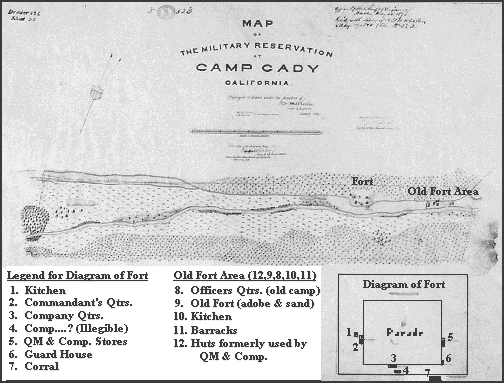Covert Observations at Camp Cady
In March 1862 Camp Carleton was abandoned in San Bernardino, but the Army kept a watch on the desert, especially since information had been received that a large body of men was camped east of Beale's Crossing. Cavalry Lieutenant Nathaniel P. Pierce of the 2nd Cavalry, California Volunteers, was ordered to proceed to the abandoned Camp Cady site with ten men, where they were to hide themselves and their animals inside and covertly observe any movements along the Mojave Road.
1869 Map of Camp Cady
THE LEGEND AND THE CORRESPONDING NUMBERS ON THE MAP AND FORT DIAGRAM WERE TOO SMALL TO READ, SO THE INFORMATION HAS BEEN TYPED IN
Pierce reported that the eight-day trip to the camp was without incident, but he did hear news on the road of suspicious activity, which included sightings of men running wagonloads of gunpowder into Utah, probably intended for Brigham Young's militia:
-
[I] arrived at
Camp Cady
on the 14th of April, A. D., 1862, seeing and hearing of nothing unusual on the route, except
at Lane's Crossing of the Mojave, where I was informed by Mr. Lane that a wagon loaded with powder had crossed there a
few days previous, said to be going to Salt Lake. I remained at Camp Cady until the 24th of April, seeing and hearing
of nothing unusual, and meeting no parties that I could suspect of treasonable intentions toward the Government.
On the 24th I left Camp Cady for Camp Latham, and on arriving at Lane's Crossing...I was informed by Mr. Lane that during my absence...another wagon loaded with powder, said to be for Salt Lake, had passed. I was informed by the parties keeping the toll gate at Cajon Pass that armed men in small parties had been passing through all the winter and spring.
In May of 1863 Fort Mojave was reactivated. With its reinstatement, there were few problems with the Indians in the vicinity of the fort, but in other parts of the desert they became more and more troublesome, and it was reported in August that Aaron was even temporarily forced from his home:
-
The Indians about Camp Cady [and] Lane's Rancho, are becoming quite hostile, Mr. Lane himself being compelled to pull up stakes
and leave. It is to be hoped the officers at Fort Mojave will attend to this matter, and see that the settlers in that section
receive the protection they were sent there to impart.

D'Heureuse photo, courtesy Bancroft Library
CAMP CADY IN 1863
< Previous - Next >